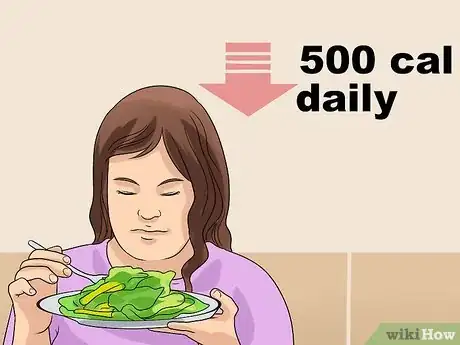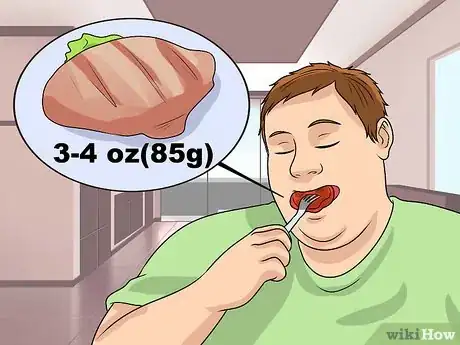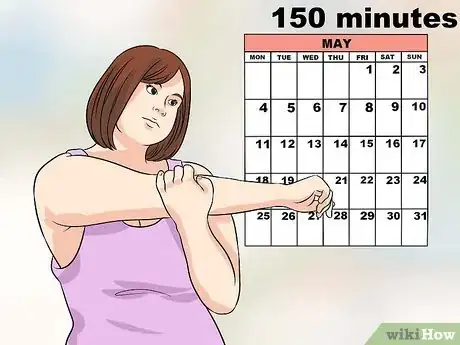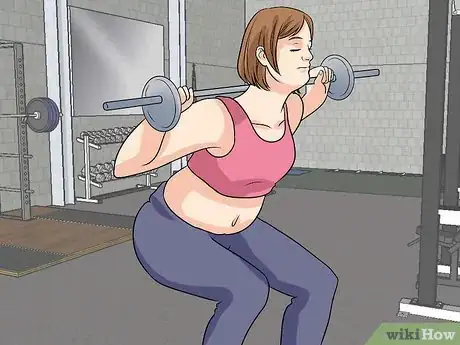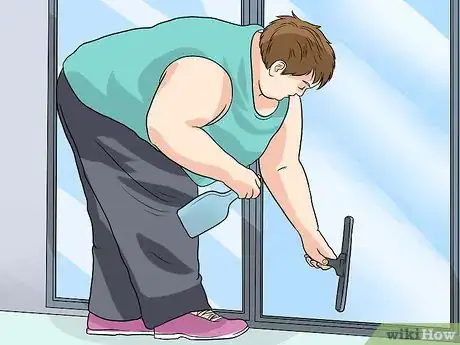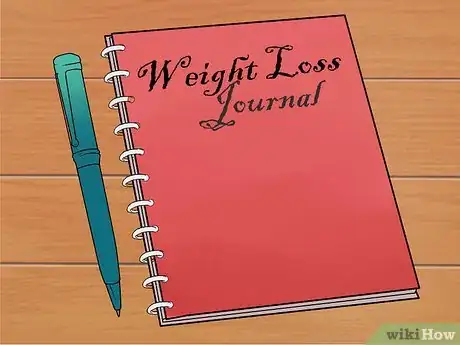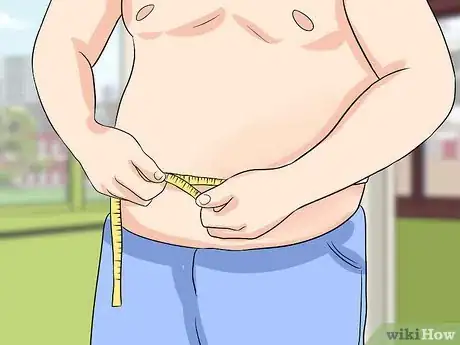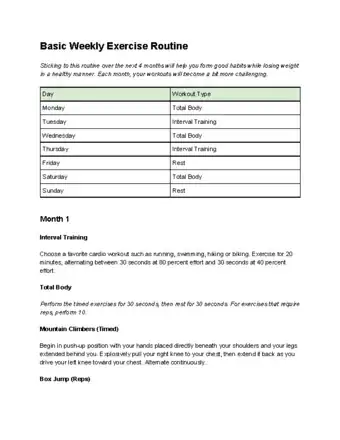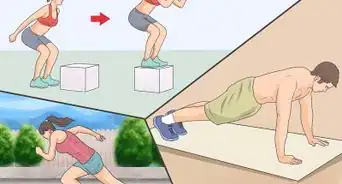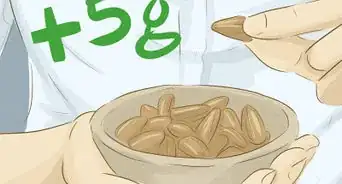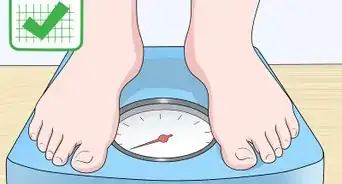This article was co-authored by Julian Arana, M.S.eD., NCSF-CPT. Julian Arana is a Personal Trainer and the Founder of B-Fit Training Studios, a personal training and wellness set of studios based in Miami, Florida. Julian has over 12 years of personal training and coaching experience. He is a certified personal trainer (CPT) by the National Council on Strength and Fitness (NCSF). He has a BS in Exercise Physiology from Florida International University and an MS in Exercise Physiology specializing in strength and conditioning from the University of Miami.
There are 14 references cited in this article, which can be found at the bottom of the page.
This article has been viewed 133,485 times.
Giving yourself four months to lose weight is a significant amount of time. You'll be able to lose a considerable amount of weight and make great progress on your weight and health goals. In addition to weight loss, a four month time span will allow you to see improvements in your cardiovascular fitness if you're exercising regularly. Start by making small changes to diet and exercise so that you can adopt a healthier lifestyle within your four month time frame.
Steps
Making Dietary Changes to Help Lose Weight in Four Months
-
1Reduce calories and portion sizes. In the course of four months, you can lose a considerable amount of weight just by watching your calorie intake and portion sizes.[1]
- If you cut out about 500 calories daily from your diet and incorporate exercise, you'll lose about 1 to 2 pounds per week. That means, in about four months, you can lose around 16 to 30 pounds.
- Another way to decrease calories is by monitoring your portion sizes. Larger portion sizes may tempt you to eat more food in one sitting and, therefore, more calories than your body needs.
- Measure out a 1 to 2 cup (8 to 16 oz) total portion size per meal. This should leave you feeling satisfied-not overly full.
-
2Aim to eat a balanced diet. Regardless of how much weight you want to lose or how many calories you're cutting from your diet, it's always important to follow a well-balanced diet.
- A well-balanced diet is one in which you eat foods from each and every food group most days. In addition, you follow the appropriate portion sizes and choose a wide variety of foods from each food group.[2]
- Include a 3 to 4 oz (about 85 g) serving of lean protein at each meal.[3] Choose items like: poultry, eggs, tofu, legumes, seafood or low-fat dairy. These foods will help support and fuel your weight loss and help control your hunger.
- Make half your plate or meal vegetables. Incorporate a 1 cup (8 oz) serving of vegetables or 2 cups of salad greens.[4] Vegetables can bulk up your meals while adding very few overall calories. You can eat 1 serving (1/2 cup or 4 oz.) of fruit as a treat or dessert.
- Serve yourself 1/2 cup or 1 oz portion of 100% whole grains.[5] Including a serving or two of these during the day helps add beneficial fiber to your diet.
Advertisement -
3Limit snacking. Having an occasional snack won't ruin or stall weight loss. In fact, a well-timed and well-planned snack can actually aid weight loss. Snacks can give you a boost of energy, extra hit of nutrition or the fuel for a tough workout. You need to be smart about the type of snacks you choose, and when to eat a snack.
- If you're choosing to have a snack while losing weight, aim for a 150 calorie snack. This will help you stick to a lower calorie level overall and still allow you to lose a decent amount of weight within four months.[6]
- Also, make sure that you include some protein and a fruit or vegetable for your snacks. The protein and fiber combination can help give you some energy and keep you satisfied longer.
- Only snack if you truly need to or are physically hungry or if there is more than four hours between your meals. Avoid snacking out of boredom or stress.
- Smart snack options include: a small Greek yogurt, a piece of fruit and low-fat cheese stick, 1/4 cup of trail mix, one hard boiled egg or 1 oz of nuts and 1/2 cup of grapes.
-
4Avoid high-calorie processed foods. When you're trying to lose weight in four months, there are certain foods you should limit or try to avoid. Processed foods can stall weight loss when eaten regularly or in large quantities.
- Many processed foods are high in calories, added sugars, harmful fats and other preservatives and additives.[7] Limiting these foods from your diet will help you stick to a lower calorie and more nutritious diet plan.
- Avoid the processed foods that won't help weight loss like: sweetened beverages (regular soda, alcohol, mixed coffee drinks and fruit juices), breakfast pastries, candy, cookies, cakes and pies, frozen meals, ice cream, processed meats, fried foods, fast foods, chips and crackers and canned meals.
-
5Drink adequate fluids daily. Water can play an important role in your weight loss plan. Drinking enough will be important to your health and diet.
- Most health professionals recommend you drink at least eight 8-oz glasses (about 2 liters) daily; however, if you're more active, you may need up to 13 glasses (3 liters) daily.[8]
- You know you're well-hydrated when you're not typically thirsty throughout the day and your urine is the color of lemonade or very pale yellow by the end of the day.
- Water is great for weight loss because it can quell your appetite throughout the day.[9] In addition, drinking a large glass of water before a meal can make it easier for you to stick to a smaller portion since you're feeling full on the water.
Adding Physical Activity to Lose Weight in Four Months
-
1Do 150 minutes of cardio each week. In addition to diet, another important part of your weight loss plan will be physical activity — especially cardio.[10] Even within a four month time period, this type of exercise can heavily influence your weight loss.
- Including regular amounts of cardio throughout the week will help support your weight loss.[11] These activities raise your heart rate and can burn a significant amount of calories.
- At a minimum, include 150 minutes or 2 1/2 hours of cardio or aerobic activities each week. This will give you the weight loss benefit as well as many health benefits.
- Include moderate cardio activities like: jogging/walking, dancing, cycling, taking an aerobics class or doing water aerobics.
-
2Include one to three days of strength training. In addition to cardio, it's also beneficial to add in regular strength training to your exercise routine.[12] This type of activity can also support weight loss.[13]
- Participating in 20 minutes of strength training one to three times each week can help build lean muscle mass, prevent osteoporosis and increase your metabolism.[14]
- If you have increased lean muscle mass, your body is able to burn more calories at rest. Within four months, you can make a significant difference in your body's lean muscle mass and metabolism.
-
3Increase lifestyle activity. Increased cardio and strength training can offer many benefits to weight loss, but it's not the only way — increasing your lifestyle activity has been shown to be equally beneficial.[15] Again, in a four month time period this extra activity can really affect your overall weight loss.
- Lifestyle activities are exercises that you already do as part of your typical day. For example, taking the stairs, walking to and from your car, walking to go get the mail or doing household chores.
- Many studies have shown that these activities are equally as beneficial to weight loss and overall health as planned or structured cardiovascular exercise.
- Try to think of ways you can increase your overall exercise. For example, can you park farther away from your office? Can you schedule in a 10 minute walk break or yoga session on your lunch hour? Can you take more stairs? These activities will get you moving more and help burn more calories throughout the day.
-
4Include one to two rest days a week. In the course of four months, you may make significant progress on your weight loss as well as on your physical fitness level. At the same time, you need to be careful and aim to prevent injuries as you ramp up your activity levels.
- It's important to take good care of your body and let it rest and recovery during "off days" planned during the week.[16]
- Many strength and muscle mass gains actually occur during rest.[17] In addition, your body needs to rest and recover so that it continue performing at your current fitness level.
- Also, if you never plan a rest day, you actually might see a plateau or stall in your weight loss progress.[18]
Reevaluating After Four Months of Weight Loss
-
1Journal. Journaling is a great addition to any weight loss plan. This will be especially true while you're losing weight over a longer time period like four months.
- You can write about your goals in your journal and your progress as well.
- In addition, it might be smart to track your foods and keep a food diary. It can help keep you accountable and help give you an idea of what's working or not working in your diet plan.[19]
-
2Track your weight and measurements. During the four month weight loss period, consider tracking your weight and other measurements.
- Tracking your progress through weight and different measurements can help you decide how well your diet is or isn't working.
- Weigh yourself about one to two times a week. Also, Weigh yourself at the same time of day, in the same clothes (or without clothes), on the same day of the week. This helps you see a more accurate weight loss trend.
- In addition to weight, you can track different measurements. Measure your waist, hips, thighs or arms. Only track these measurements once a month so you'll be able to see any changes.
-
3Make changes. After your four month weight loss plan is up, consider reevaluating your progress, goals and any changes you want to make.
- After four months, you might be satisfied with your weight loss. If so, keep up with the healthy lifestyle behaviors you've adopted. Completely reverting back to previous habits may cause you to regain the weight you've lost.
- If you're enjoying the weight loss and think you'd like to lose more, continue with your current diet and exercise plan.
- If you've struggled with weight loss and still want to lose more weight, reevaluate your plan. Did you not exercise enough? Did you snack more often than you should? Review food journals or exercise logs to see where you can make changes. Make the necessary adjustments and keep on going!
Workout Routine and Diet Plan
Expert Q&A
-
QuestionHow can I get fit in four months?
 Julian Arana, M.S.eD., NCSF-CPTJulian Arana is a Personal Trainer and the Founder of B-Fit Training Studios, a personal training and wellness set of studios based in Miami, Florida. Julian has over 12 years of personal training and coaching experience. He is a certified personal trainer (CPT) by the National Council on Strength and Fitness (NCSF). He has a BS in Exercise Physiology from Florida International University and an MS in Exercise Physiology specializing in strength and conditioning from the University of Miami.
Julian Arana, M.S.eD., NCSF-CPTJulian Arana is a Personal Trainer and the Founder of B-Fit Training Studios, a personal training and wellness set of studios based in Miami, Florida. Julian has over 12 years of personal training and coaching experience. He is a certified personal trainer (CPT) by the National Council on Strength and Fitness (NCSF). He has a BS in Exercise Physiology from Florida International University and an MS in Exercise Physiology specializing in strength and conditioning from the University of Miami.
Certified Personal Trainer The best way to get fit quickly is to use a combination of cardio, strength training, and eating fewer calories. Keep in mind that developing a consistent fitness routine will be more beneficial in the long run than trying to see quick results.
The best way to get fit quickly is to use a combination of cardio, strength training, and eating fewer calories. Keep in mind that developing a consistent fitness routine will be more beneficial in the long run than trying to see quick results. -
QuestionHow can I decrease my weight within 4 months if I go to the gym?
 Michele DolanMichele Dolan is a BCRPA certified Personal Trainer in British Columbia. She has been a personal trainer and fitness instructor since 2002.
Michele DolanMichele Dolan is a BCRPA certified Personal Trainer in British Columbia. She has been a personal trainer and fitness instructor since 2002.
Certified Fitness Trainer Exercising burns calories. We need to burn 3,500 calories to lose one pound of fat. So, assuming you do not change your eating at all, going to the gym and exercising can reduce your weight. If you have excess fat, you will want to try and burn about 3,500 calories every week or every two weeks by exercising. Running on a treadmill at the gym or outside will burn anywhere from 400 to 550 calories an hour. Do that seven times and you can burn off one pound of fat. Building muscle by weight training at the gym also helps burn more calories, so strength training is also recommended for those wanting to lose weight.
Exercising burns calories. We need to burn 3,500 calories to lose one pound of fat. So, assuming you do not change your eating at all, going to the gym and exercising can reduce your weight. If you have excess fat, you will want to try and burn about 3,500 calories every week or every two weeks by exercising. Running on a treadmill at the gym or outside will burn anywhere from 400 to 550 calories an hour. Do that seven times and you can burn off one pound of fat. Building muscle by weight training at the gym also helps burn more calories, so strength training is also recommended for those wanting to lose weight. -
QuestionHow much weight can I lose in four months?
 Michele DolanMichele Dolan is a BCRPA certified Personal Trainer in British Columbia. She has been a personal trainer and fitness instructor since 2002.
Michele DolanMichele Dolan is a BCRPA certified Personal Trainer in British Columbia. She has been a personal trainer and fitness instructor since 2002.
Certified Fitness Trainer It would be considered advisable to limit weight loss to 1-2 pounds per week, so 16-32 pounds might be lost safely in four months.
It would be considered advisable to limit weight loss to 1-2 pounds per week, so 16-32 pounds might be lost safely in four months.
References
- ↑ Julian Arana, M.S.eD., NCSF-CPT. Certified Personal Trainer. Expert Interview. 19 May 2020.
- ↑ http://www.nhs.uk/Livewell/Goodfood/Pages/Healthyeating.aspx
- ↑ http://www.choosemyplate.gov/protein-foods
- ↑ http://www.choosemyplate.gov/vegetables
- ↑ http://www.choosemyplate.gov/grains
- ↑ http://www.mayoclinic.org/healthy-lifestyle/weight-loss/in-depth/healthy-diet/art-20046267
- ↑ http://www.nhs.uk/livewell/goodfood/pages/what-are-processed-foods.aspx
- ↑ http://www.mayoclinic.org/healthy-lifestyle/nutrition-and-healthy-eating/in-depth/water/art-20044256
- ↑ http://www.health.com/health/m/gallery/0,,20920951_2,00.html
- ↑ Julian Arana, M.S.eD., NCSF-CPT. Certified Personal Trainer. Expert Interview. 19 May 2020.
- ↑ http://www.cdc.gov/physicalactivity/basics/adults/
- ↑ Julian Arana, M.S.eD., NCSF-CPT. Certified Personal Trainer. Expert Interview. 19 May 2020.
- ↑ http://www.cdc.gov/physicalactivity/basics/pa-health/index.htm
- ↑ http://www.cdc.gov/physicalactivity/basics/adults/
- ↑ http://www.ncbi.nlm.nih.gov/pubmed/9929086
- ↑ http://www.shape.com/fitness/workouts/9-reasons-skip-your-workout-sometimes
- ↑ http://www.shape.com/fitness/workouts/9-reasons-skip-your-workout-sometimes
- ↑ http://www.shape.com/fitness/workouts/9-reasons-skip-your-workout-sometimes
- ↑ http://www.prevention.com/weight-loss/weight-loss-tips/keeping-food-journals-leads-weight-loss
About This Article
To lose weight in 4 months, aim to eat a balanced diet of all five food groups to avoid overeating fattening foods. Also, try your best to avoid processed and junk foods, as these are often high in calories. Additionally, try to do 150 minutes of cardio exercise each week, such as jogging, cycling, or dancing, to burn off calories. Also, aim to drink around 2 liters of water a day, as this will help to reduce your appetite. For more tips from our Personal trainer co-author, including how to keep track of your weight over the months, read on!
